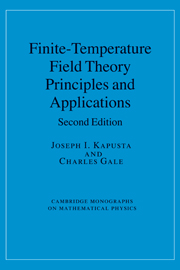Book contents
- Frontmatter
- Contents
- Preface
- 1 Review of quantum statistical mechanics
- 2 Functional integral representation of the partition function
- 3 Interactions and diagrammatic techniques
- 4 Renormalization
- 5 Quantum electrodynamics
- 6 Linear response theory
- 7 Spontaneous symmetry breaking and restoration
- 8 Quantum chromodynamics
- 9 Resummation and hard thermal loops
- 10 Lattice gauge theory
- 11 Dense nuclear matter
- 12 Hot hadronic matter
- 13 Nucleation theory
- 14 Heavy ion collisions
- 15 Weak interactions
- 16 Astrophysics and cosmology
- Conclusion
- Appendix
- Index
8 - Quantum chromodynamics
Published online by Cambridge University Press: 04 November 2009
- Frontmatter
- Contents
- Preface
- 1 Review of quantum statistical mechanics
- 2 Functional integral representation of the partition function
- 3 Interactions and diagrammatic techniques
- 4 Renormalization
- 5 Quantum electrodynamics
- 6 Linear response theory
- 7 Spontaneous symmetry breaking and restoration
- 8 Quantum chromodynamics
- 9 Resummation and hard thermal loops
- 10 Lattice gauge theory
- 11 Dense nuclear matter
- 12 Hot hadronic matter
- 13 Nucleation theory
- 14 Heavy ion collisions
- 15 Weak interactions
- 16 Astrophysics and cosmology
- Conclusion
- Appendix
- Index
Summary
The quark model of hadrons, developed by Gell-Mann and Zweig, began to be taken seriously in the mid to late 1960s. The discovery of scaling in deep inelastic electron–nucleon reactions in the late 1960s seemed to imply that at very short distances, or very high momentum transfers, the nucleon constituents (valence quarks) behaved like weakly interacting point particles. However, the interactions between quarks had to be very strong at long distances, or small momentum transfers, to confine them in hadrons and thus explain the non-observation of isolated quarks. Politzer and Gross and Wilczek, who received the Nobel prize in 2004, showed that the only renormalizable field theory of quarks that had the property of an increasing force at long distance and a decreasing force at short distance was of the type discovered by Yang and Mills. Quarks must be spin-1/2 fermions, with fractional electric charge, and must come in three colors (a new quantum charge akin to electric charge) in order to explain the systematics of hadron spectroscopy. Interactions between quarks are mediated by gluons (the glue which holds them together). Gluons are massless spin-1 bosons, as are photons, but unlike photons they interact among themselves directly (via point interactions) because they also carry a color charge. Such theories are called nonabelian gauge theories. This theory of quarks and gluons, quantum chromodynamics (QCD), is the accepted theory of the strong interactions. Unfortunately, it has been very difficult to make quantitative predictions with QCD, owing to its complexity and peculiar properties. For a more thorough discussion of the history of QCD and its experimental support see Close.
- Type
- Chapter
- Information
- Finite-Temperature Field TheoryPrinciples and Applications, pp. 135 - 176Publisher: Cambridge University PressPrint publication year: 2006



